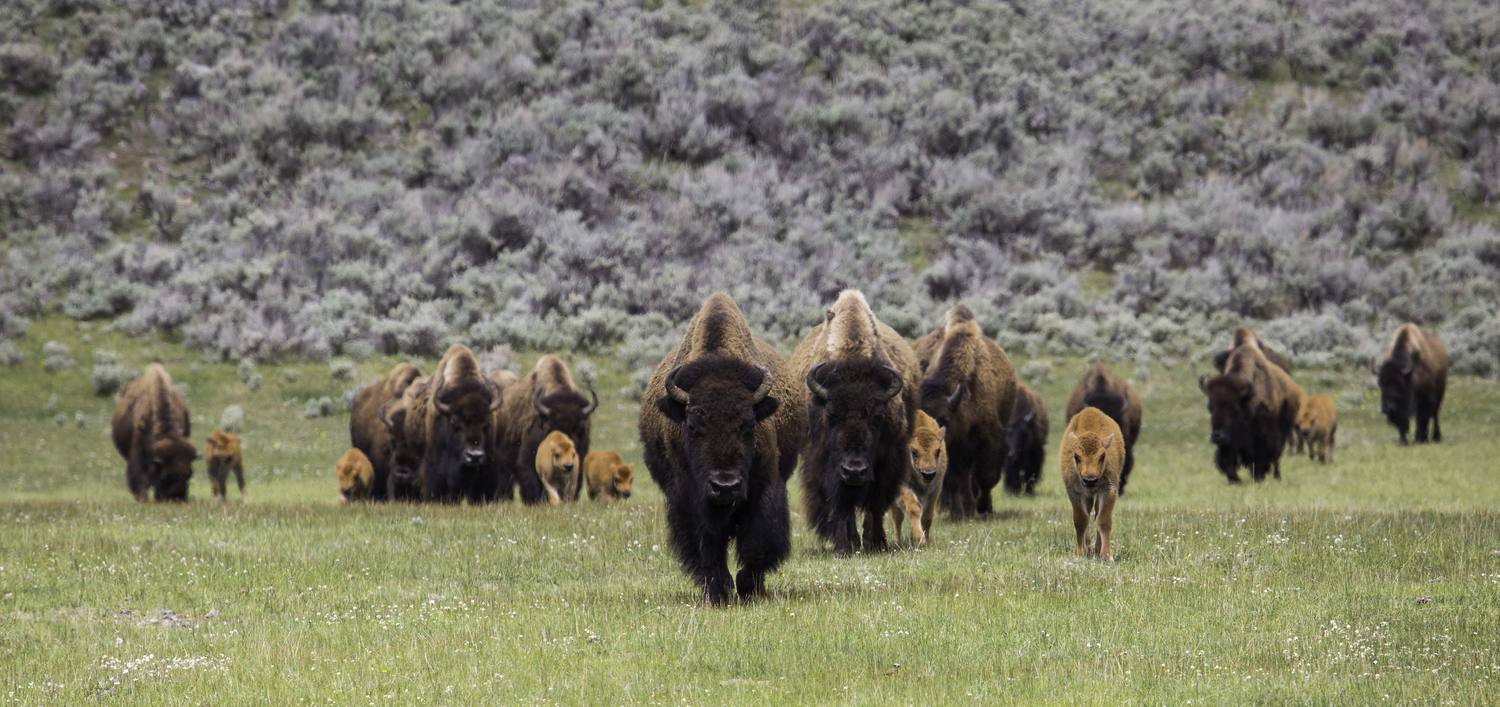


My eyes widened and I flung my hand toward the windshield. “Buffalo!”
Our driver slammed on the brakes. We braced ourselves for impact. We were on a collision course, all of us certain the massive creature barreling toward us in the dark would slam into the side of our truck at any second. The vehicle couldn’t stop fast enough. We were in trouble. The cab filled with our panicked cries, and I clutched the dashboard, bracing for impact. Our rim-to-rim Grand Canyon backpacking trip was about to end before it began, shattered by a bison on a lonely road along the North Rim.
Then, just as the truck jolted to a stop, the animal swerved, missing us by mere inches.
We sat motionless in our seats, still yelling in terror. We nearly got bulldozed by a bison in a National Park. Gradually, our cries turned into nervous laughter as we realized we had made it through completely unscathed. All of us clutched our hearts, checked to make sure our pants were dry, and, shaking with adrenaline, exchanged excited exclamations. Once our heart rates returned to normal, we carried on, very slowly pulling into the next turnoff, eager to set up camp and abandon the road for the night.
Unfortunately, bison encounters like these aren’t all that uncommon, especially in populated places like national parks. My experience was likely just coincidence—we simply happened to drive into the path of a galloping bison—but many other situations that result in people being charged or gored by these creatures are avoidable.
Where the buffalo roam
Bison, often colloquially referred to as buffalo, are scattered across much of the U.S. The largest population can be found in western states such as Wyoming, Montana, and Colorado, but protected herds may roam as far east as Kentucky. The biggest single herd of wild bison, meanwhile (about 4,500 members), is in Yellowstone National Park, the only place in the States where bison have lived continually since prehistoric times.
But these car-sized creatures also live in close proximity to a lot of people—Yellowstone hosted more than 4.1 million visitors last year. This means park rangers have to work hard to keep man and beast living in harmony. Unfortunately, that’s not always possible. Despite the park’s best efforts, bison injure more people than any other animal within its 3,500 square-mile area, including bears. Fortunately, almost all bison attacks are entirely preventable.
Keep your distance
Bison may look like big, cuddly, slow-moving animals; they are anything but. The herbivorous ruminants can weigh as much as 2,000 pounds, but will run at speeds up to 35 mph (three times faster than humans), and jump over objects up to 5 feet tall. They’re agile, good swimmers, too, and have exceptional vision, hearing, and sense of smell. They’re most aggressive during their mating season in late July and August, and calving season in April and May.
Most of the time, bison seem to tolerate the presence of people, but if you come too close, they may lash out.
“Stay at least 25 yards away from bison,” implores Linda Veress, parks spokesperson for Yellowstone National Park. “All they want is their space.”
Invade that space and bison may charge if they feel threatened. If they do, they’re liable to toss or push people out of the way. In 2015, five visitors were butted, tossed, or gored by bison. In 2018, a woman was gored when the crowd she was in approached within 15 feet. Another was head-butted as she rounded a bend in the trail. Both escaped with relatively minor injuries, but no bison encounter should be taken lightly.
Veress and the rest of the staff at Yellowstone encourage people to not only stay back, but stay in their cars if bison are on the side of the road. Too many people try to see how close they can get to a bison for a photo, or turn their back to one for a selfie, then are surprised when it stands up or starts trotting in their direction.
“They’re wild animals. They’re unpredictable.” Veress says. “They act aggressively when they feel threatened.”
The trick is not only to keep your distance, but use your head. If you want to get a good look without endangering yourself or the animals, Veress recommends binoculars or a telephoto camera lens. And if they’re in or alongside the road, you may roll down your window to get a better look, but don’t get out of the car.
“If you cause an animal to move, you’re too close,” Veress says. That goes for public parks and wilderness areas alike.
Veress has had to follow her own advice on at least one occasion. While hiking in Yellowstone, in an area far from paved pathways and boardwalks, she encountered several bison standing on both sides of the path. Instead of tiptoeing through and hoping for the best, she went off-trail and walked around, giving the animals at least 100 yards of space while she kept a close eye on them. In similarly wild areas, where the beasts roam freely, it’s important to pay close attention to your surroundings, she says.
There’s not much else you can do
Unlike dealing with bears, mountain lions, and other wildlife, no amount of noise, waving your arms, or making yourself appear larger will increase your chances of survival when you’ve angered a bison. You could carry bear spray to discourage a charge, but unless you see the animal approaching from a long way off, you may not have time to use the spray.
If you happen to round a corner and find yourself in close proximity to an animal, back away slowly and quietly to show you’re not a threat and hope your appearance didn’t startle it. Your best course of action: keep your distance and stay alert. The best offense is a good defense.
